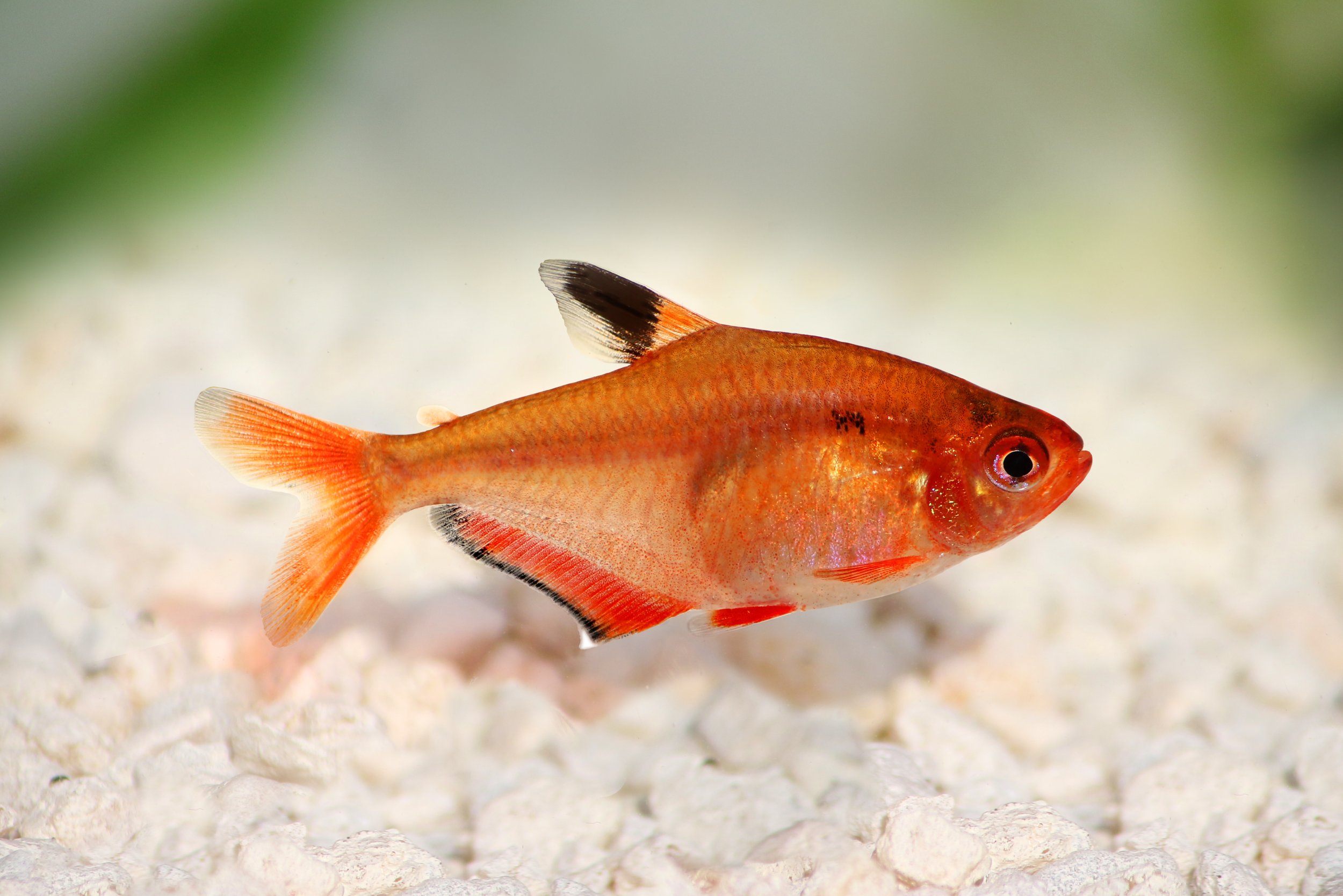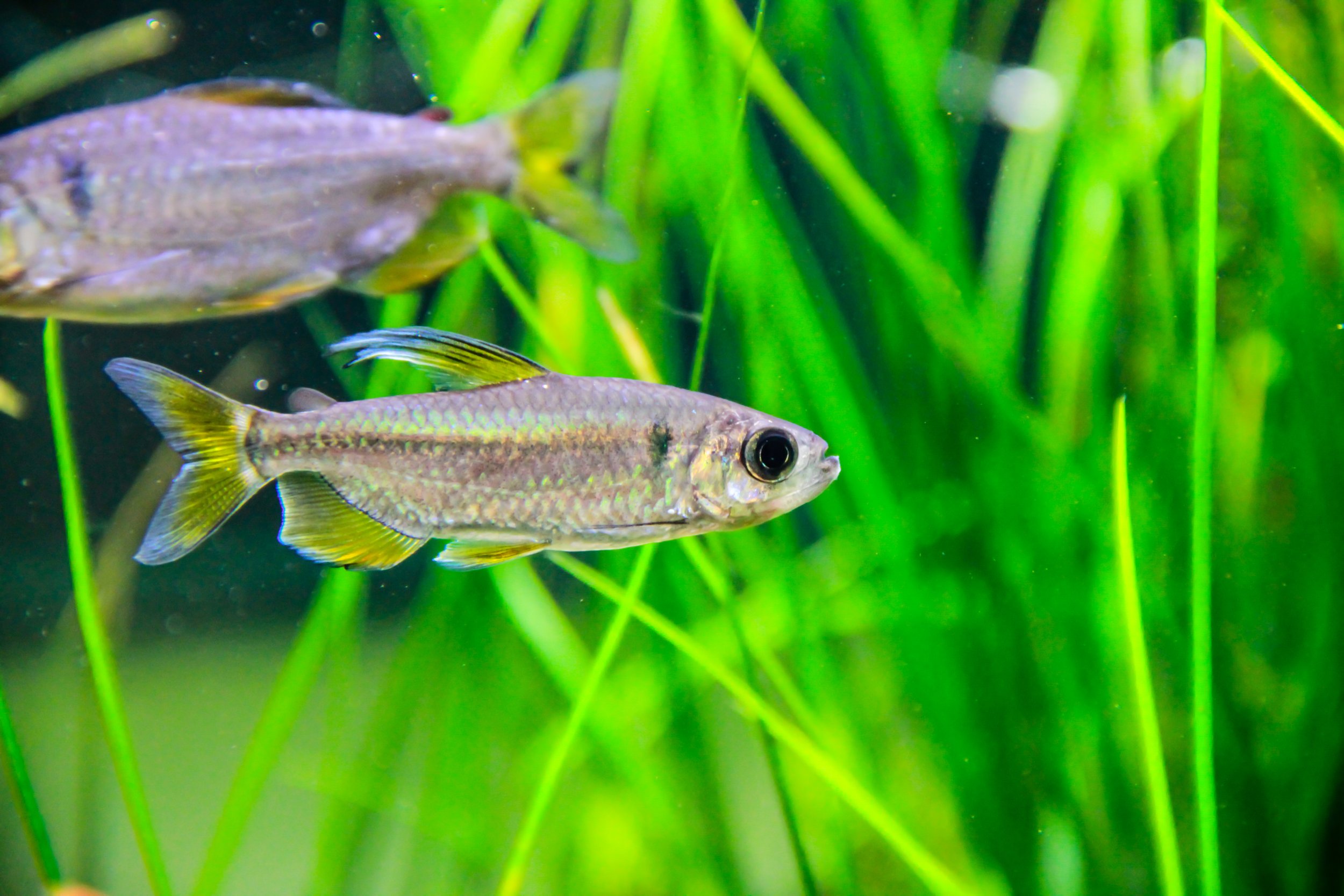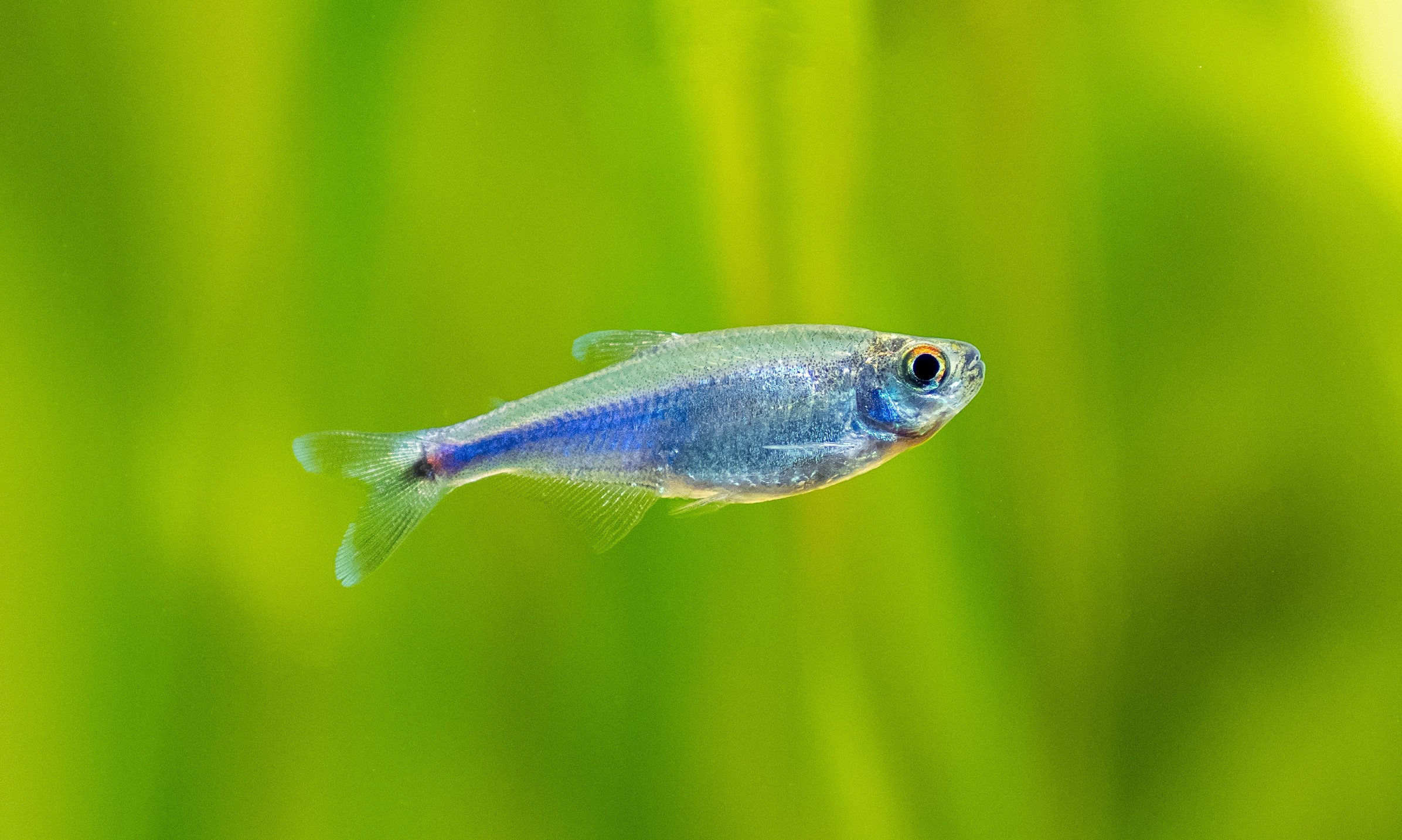 Image 1 of 3
Image 1 of 3

 Image 2 of 3
Image 2 of 3

 Image 3 of 3
Image 3 of 3




Serpae Tetra
The Serpae Tetra, scientifically known as Hyphessobrycon eques, is a popular and lively freshwater fish native to the slow-moving rivers, streams, and flooded areas of the Amazon Basin in South America, particularly in Brazil, Bolivia, and Paraguay. Known for its bright red coloration and playful yet sometimes feisty temperament, the Serpae Tetra is a favorite among aquarists who enjoy keeping active, colorful fish. It makes an excellent addition to planted and community tanks, provided that its tank mates are chosen carefully.
Physical Description:
The Serpae Tetra is characterized by its vibrant, fiery red body, which makes it an eye-catching addition to any aquarium. It has a distinct black spot located just behind the gills and a slightly translucent dorsal fin edged in white or black, adding to its visual appeal. Its other fins are often tinted red, and the combination of colors gives it a striking, flame-like appearance. Adult Serpae Tetras typically reach a size of about 1.5 to 2 inches (4 to 5 centimeters), making them a manageable size for most aquariums.
Aquarium Care:
Serpae Tetras thrive in well-planted tanks with plenty of swimming space. They are active fish and enjoy exploring, so a tank with a mix of open areas and shaded regions created by plants or driftwood is ideal. While they are relatively hardy and adaptable, it is best to keep them in a tank of at least 20 gallons to provide adequate space for a school. Serpae Tetras are schooling fish and should be kept in groups of six or more to minimize any fin-nipping behavior and reduce stress.
Water Parameters:
To replicate their natural environment, Serpae Tetras prefer slightly acidic to neutral water with a pH range of 6.0 to 7.5. They are comfortable in a temperature range of 72 to 79°F (22 to 26°C), which makes them compatible with a variety of tank mates. Regular water changes and good filtration are essential to maintain water quality, as they are sensitive to poor water conditions. Adding driftwood or Indian almond leaves can help soften the water and create a more natural blackwater effect, which these tetras enjoy.
Feeding:
Serpae Tetras are omnivores and have a hearty appetite. They readily accept a wide variety of foods, including high-quality flakes, micro-pellets, and live or frozen foods such as bloodworms, brine shrimp, and daphnia. A varied diet helps to enhance their color and ensure their overall health. It is best to feed them small amounts twice daily to prevent overfeeding and maintain water quality.
Temperament and Tank Mates:
Serpae Tetras are known for their semi-aggressive temperament, particularly their tendency to nip the fins of slower or long-finned tank mates. For this reason, they are best kept with other active, short-finned fish that can handle their sometimes feisty behavior. Suitable tank mates include other tetras (like Black Neon Tetras or Rummy-Nose Tetras), rasboras, barbs, and bottom-dwelling species like Corydoras catfish. Avoid housing them with slow-moving or long-finned fish such as guppies or angelfish, as they may be targets for fin-nipping.
Breeding:
Breeding Serpae Tetras in captivity is possible and relatively straightforward. They are egg scatterers, and spawning is often triggered by conditioning the pair with live or frozen foods and providing a slightly warmer temperature. A breeding tank with fine-leaved plants or a spawning mop is ideal, as the female will scatter her eggs among them. Once the eggs are laid, it’s best to remove the adults, as they may eat the eggs. The eggs typically hatch within 24 to 36 hours, and the fry become free-swimming a few days later. They can be fed on infusoria or powdered fry food until they are large enough to eat baby brine shrimp.
Overall:
The Serpae Tetra (Hyphessobrycon eques) is a colorful and energetic addition to freshwater aquariums. Their vibrant appearance and lively nature make them a captivating choice for aquarists, especially those who enjoy schooling fish. With proper care, attention to tank mates, and a well-maintained environment, Serpae Tetras can thrive and add a dynamic touch of color to any community setup.
The Serpae Tetra, scientifically known as Hyphessobrycon eques, is a popular and lively freshwater fish native to the slow-moving rivers, streams, and flooded areas of the Amazon Basin in South America, particularly in Brazil, Bolivia, and Paraguay. Known for its bright red coloration and playful yet sometimes feisty temperament, the Serpae Tetra is a favorite among aquarists who enjoy keeping active, colorful fish. It makes an excellent addition to planted and community tanks, provided that its tank mates are chosen carefully.
Physical Description:
The Serpae Tetra is characterized by its vibrant, fiery red body, which makes it an eye-catching addition to any aquarium. It has a distinct black spot located just behind the gills and a slightly translucent dorsal fin edged in white or black, adding to its visual appeal. Its other fins are often tinted red, and the combination of colors gives it a striking, flame-like appearance. Adult Serpae Tetras typically reach a size of about 1.5 to 2 inches (4 to 5 centimeters), making them a manageable size for most aquariums.
Aquarium Care:
Serpae Tetras thrive in well-planted tanks with plenty of swimming space. They are active fish and enjoy exploring, so a tank with a mix of open areas and shaded regions created by plants or driftwood is ideal. While they are relatively hardy and adaptable, it is best to keep them in a tank of at least 20 gallons to provide adequate space for a school. Serpae Tetras are schooling fish and should be kept in groups of six or more to minimize any fin-nipping behavior and reduce stress.
Water Parameters:
To replicate their natural environment, Serpae Tetras prefer slightly acidic to neutral water with a pH range of 6.0 to 7.5. They are comfortable in a temperature range of 72 to 79°F (22 to 26°C), which makes them compatible with a variety of tank mates. Regular water changes and good filtration are essential to maintain water quality, as they are sensitive to poor water conditions. Adding driftwood or Indian almond leaves can help soften the water and create a more natural blackwater effect, which these tetras enjoy.
Feeding:
Serpae Tetras are omnivores and have a hearty appetite. They readily accept a wide variety of foods, including high-quality flakes, micro-pellets, and live or frozen foods such as bloodworms, brine shrimp, and daphnia. A varied diet helps to enhance their color and ensure their overall health. It is best to feed them small amounts twice daily to prevent overfeeding and maintain water quality.
Temperament and Tank Mates:
Serpae Tetras are known for their semi-aggressive temperament, particularly their tendency to nip the fins of slower or long-finned tank mates. For this reason, they are best kept with other active, short-finned fish that can handle their sometimes feisty behavior. Suitable tank mates include other tetras (like Black Neon Tetras or Rummy-Nose Tetras), rasboras, barbs, and bottom-dwelling species like Corydoras catfish. Avoid housing them with slow-moving or long-finned fish such as guppies or angelfish, as they may be targets for fin-nipping.
Breeding:
Breeding Serpae Tetras in captivity is possible and relatively straightforward. They are egg scatterers, and spawning is often triggered by conditioning the pair with live or frozen foods and providing a slightly warmer temperature. A breeding tank with fine-leaved plants or a spawning mop is ideal, as the female will scatter her eggs among them. Once the eggs are laid, it’s best to remove the adults, as they may eat the eggs. The eggs typically hatch within 24 to 36 hours, and the fry become free-swimming a few days later. They can be fed on infusoria or powdered fry food until they are large enough to eat baby brine shrimp.
Overall:
The Serpae Tetra (Hyphessobrycon eques) is a colorful and energetic addition to freshwater aquariums. Their vibrant appearance and lively nature make them a captivating choice for aquarists, especially those who enjoy schooling fish. With proper care, attention to tank mates, and a well-maintained environment, Serpae Tetras can thrive and add a dynamic touch of color to any community setup.
The Serpae Tetra, scientifically known as Hyphessobrycon eques, is a popular and lively freshwater fish native to the slow-moving rivers, streams, and flooded areas of the Amazon Basin in South America, particularly in Brazil, Bolivia, and Paraguay. Known for its bright red coloration and playful yet sometimes feisty temperament, the Serpae Tetra is a favorite among aquarists who enjoy keeping active, colorful fish. It makes an excellent addition to planted and community tanks, provided that its tank mates are chosen carefully.
Physical Description:
The Serpae Tetra is characterized by its vibrant, fiery red body, which makes it an eye-catching addition to any aquarium. It has a distinct black spot located just behind the gills and a slightly translucent dorsal fin edged in white or black, adding to its visual appeal. Its other fins are often tinted red, and the combination of colors gives it a striking, flame-like appearance. Adult Serpae Tetras typically reach a size of about 1.5 to 2 inches (4 to 5 centimeters), making them a manageable size for most aquariums.
Aquarium Care:
Serpae Tetras thrive in well-planted tanks with plenty of swimming space. They are active fish and enjoy exploring, so a tank with a mix of open areas and shaded regions created by plants or driftwood is ideal. While they are relatively hardy and adaptable, it is best to keep them in a tank of at least 20 gallons to provide adequate space for a school. Serpae Tetras are schooling fish and should be kept in groups of six or more to minimize any fin-nipping behavior and reduce stress.
Water Parameters:
To replicate their natural environment, Serpae Tetras prefer slightly acidic to neutral water with a pH range of 6.0 to 7.5. They are comfortable in a temperature range of 72 to 79°F (22 to 26°C), which makes them compatible with a variety of tank mates. Regular water changes and good filtration are essential to maintain water quality, as they are sensitive to poor water conditions. Adding driftwood or Indian almond leaves can help soften the water and create a more natural blackwater effect, which these tetras enjoy.
Feeding:
Serpae Tetras are omnivores and have a hearty appetite. They readily accept a wide variety of foods, including high-quality flakes, micro-pellets, and live or frozen foods such as bloodworms, brine shrimp, and daphnia. A varied diet helps to enhance their color and ensure their overall health. It is best to feed them small amounts twice daily to prevent overfeeding and maintain water quality.
Temperament and Tank Mates:
Serpae Tetras are known for their semi-aggressive temperament, particularly their tendency to nip the fins of slower or long-finned tank mates. For this reason, they are best kept with other active, short-finned fish that can handle their sometimes feisty behavior. Suitable tank mates include other tetras (like Black Neon Tetras or Rummy-Nose Tetras), rasboras, barbs, and bottom-dwelling species like Corydoras catfish. Avoid housing them with slow-moving or long-finned fish such as guppies or angelfish, as they may be targets for fin-nipping.
Breeding:
Breeding Serpae Tetras in captivity is possible and relatively straightforward. They are egg scatterers, and spawning is often triggered by conditioning the pair with live or frozen foods and providing a slightly warmer temperature. A breeding tank with fine-leaved plants or a spawning mop is ideal, as the female will scatter her eggs among them. Once the eggs are laid, it’s best to remove the adults, as they may eat the eggs. The eggs typically hatch within 24 to 36 hours, and the fry become free-swimming a few days later. They can be fed on infusoria or powdered fry food until they are large enough to eat baby brine shrimp.
Overall:
The Serpae Tetra (Hyphessobrycon eques) is a colorful and energetic addition to freshwater aquariums. Their vibrant appearance and lively nature make them a captivating choice for aquarists, especially those who enjoy schooling fish. With proper care, attention to tank mates, and a well-maintained environment, Serpae Tetras can thrive and add a dynamic touch of color to any community setup.








